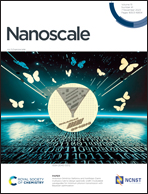Tuning the chemical composition of binary alloy nanoparticles to prevent their dissolution†
Abstract
The dissolution of nanoparticles under corrosive environments represents one of the main issues in electrochemical processes. Here, a model for alloying and protecting nanoparticles from corrosion with an anti-corrosive element (e.g. Au) is proposed based on the hypothesis that under-coordinated atoms are the first atoms to dissolve. The model considers the dissolution of atoms with coordination number ≤6 on A–B nanoparticles with different sizes, shapes, chemical compositions, and exposed crystallographic orientations. The results revealed that the nanoparticle's size and chemical composition play a key role in the dissolution, suggesting that a certain composition of an element with corrosive resistance could be used to protect nanoparticles. DFT simulations were performed to support our model on the dissolution of four types of atoms commonly found on the surface of Au0.20Pd0.80 binary alloys – terrace, edge, kink, and ad atoms. The simulations suggest that the less coordinated ad and kink Pd atoms on Au0.20Pd0.80 alloys are dissolved in a potential window between 0.26–0.56 V, while the rest of the Pd and Au atoms are protected. Furthermore, to show that a corrosion-resistant element can indeed protect nanoparticles, we experimentally investigated the electrochemical dissolution of immobilized Pd, Au0.20Pd0.80, and Au0.40Pd0.60 nanoparticles in a harsh environment. In line with the dissolution model, the experimental results show that an Au molar fraction of the nanoparticle of 0.20, i.e., Au0.20Pd0.80 binary alloy, is a good compromise between maximizing the active surface area (Pd atoms) and corrosion protection by the inactive Au.



 Please wait while we load your content...
Please wait while we load your content...